Mikoyan-Gurevich MiG-23 Videos
|
Loading...
|
|
Mikoyan-Gurevich MiG-23
MiG-23
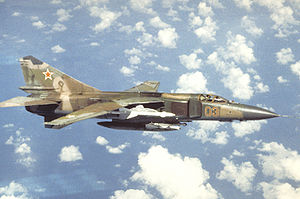
Picture - MiG-23MLD Flogger-K
Role: Intreceptor (M series)/Fighter-Bomber (B series)
Manufacturer: Mikoyan-Gurevich OKB
First flight: 10 June 1967
Introduced: 1970
Status: In service with foreign users
Primary users: Soviet Air Force
Russian Air Force
Libyan Air Force
Syrian Air Force
Produced: 1967-1985
Number built: 5,047 (MiG-23) and
Unit cost: US$3.6 million/$6.6 million depending on the customer
Variants: Mikoyan MiG-27
The Mikoyan-Gurevich MiG-23 (NATO reporting name: Flogger) is a swing-wing fighter aircraft, designed by the Mikoyan-Gurevich bureau in the Soviet Union. It is considered to belong to the Soviet "Third Generation" aircraft category along with similar-aged Russian-produced fighters such as the MiG-25 "Foxbat". It was the first attempt by the Soviet Union to design look-down/shoot-down radar and one of the first to be armed with beyond visual range missiles, and the first MiG production fighter plane to have intakes at the sides of the fuselage. Production started in 1970 and reached large numbers with over 5,000 aircraft built. Today the MiG-23 remains in limited service with various export customers.
Design and development
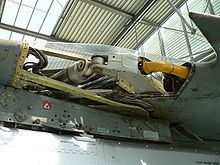
Picture - MiG-23 sweep wing mechanism.
The MiG-23's predecessor, the MiG-21 (NATO reporting name 'Fishbed'), was fast and agile, but limited in its operational capabilities by its primitive radar, short range, and limited weapons load (restricted in some aircraft to a pair of short-range air-to-air missiles). The MiG-23 was to be a heavier, more powerful machine designed to remedy these deficiencies, and rival Western aircraft like the F-4 Phantom. The new fighter was to feature a totally new S-23 sensor and weapon system suite capable of firing beyond-visual-range (BVR) missiles.
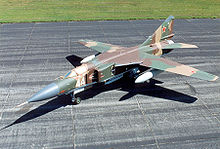
Picture - MiG-23 parked.
A major design consideration was take-off and landing performance. Existing Soviet fast jets required very long runways, which combined with their limited range, limited their tactical usefulness. The Soviet Air Force demanded the new aircraft have a much shorter take-off run. Low-level speed and handling was also to be improved over the MiG-21. This led Mikoyan to consider two alternatives: lift jets, to provide an additional lift component, and variable-geometry wings, which had been developed by TsAGI for both "clean-sheet" aircraft designs and adaptations of existing designs.
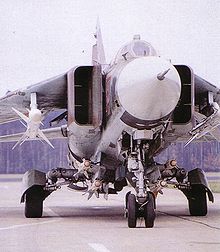
Picture - Polish MiG-23
The first prototype, called "23-01" but also known as the MiG-23PD, was a tailed delta similar to the MiG-21 but with two lift jets in the fuselage. However, it became apparent very early that this configuration was unsatisfactory, as the lift jets became useless dead weight once airborne. The second prototype, known as "23-11", featured variable-geometry wings which could be set to angles of 16, 45 and 72 degrees, and it was clearly more promising. The maiden flight of 23-11 took place on 10 June 1967, and three more prototypes were prepared for further flight and system testing. All featured the Tumansky R-27-300 turbojet engine with a thrust of 7850 kp. The order to start series production of the MiG-23 was given in December 1967.
The General Dynamics F-111 and F-4 Phantom were the main Western influences on the MiG-23. The Russians, however, wanted a much lighter, single-engine fighter to maximize agility. Both the F-111 and the MiG-23 were designed as fighters, but the heavy weight of the F-111 turned it into a long-range interdictor and kept it out of the fighter role. The MiG-23's designers kept the MiG-23 light enough to dogfight with enemy fighters.
The U.S. Air Force operated a small number of MiG-23s, officially designated YF-113, as both test and evaluation aircraft and in an aggressor role for fighter pilot training, from 1977 through 1988 in a program codenamed "Constant Peg".
First-generation
Ye-231 (Flogger-A) was the prototype built for testing, and it lacked the sawtooth leading edge that later appeared on all MiG-23/-27 models. This experimental model was the common basic design that both the MiG-23/-27 and Sukhoi Su-24 were based on, but the Su-24 experienced much greater modification.
MiG-23 (Flogger-A) was the pre-production model that lacked the hardpoints on later production versions, but the sawtooth leading edge appeared on this model, and it was also armed with guns. This model marked the divergence of the MiG-23/-27 and Su-24 from their common ancestor.
MiG-23S (Flogger-A) was the initial production variant. Only around 60 were built between 1969 and 1970. These aircraft were used for both flight and operational testing. The MiG-23S had an improved R-27F2-300 turbojet engine with a maximum thrust of 9980 kp. As the Sapfir-23 radar was delayed, the aircraft were installed with the S-21 weapons control system with the RP-22SM radar-basically the same weapons system as in the MiG-21MF/bis. A twin-barreled 23 mm GSh-23L gun with 200 rounds of ammunition was fitted under the fuselage. This variant suffered from various teething problems and was never fielded as an operational fighter.
MiG-23SM (Flogger-A) was the second pre-production variant, which was also known as the MiG-23 Type 1971. It was considerably modified compared to the MiG-23S: it had the full S-23 weapons suite, featuring a Sapfir-23L radar coupled with Vympel R-23R (NATO: AA-7 'Apex') BVR missiles. It also had a further improved R-27F2M-300 (later redesignated Khatchaturov R-29-300) engine with a maximum thrust of 12,000 kp. The modified "type 2" wing had an increased wing area and a larger sawtooth leading edge. The slats were deleted and wing sweep was increased by 2.5 degrees; wing positions were changed to 18.5, 47.5 and 74.5 degrees, respectively. The tail fin was moved further aft, and an extra fuel tank was added to the rear fuselage, as in the two-seat variant (see below). Around 80 examples were manufactured. The overall reliability was increased over the previous variant, but the Sapfir radar still proved to be immature.
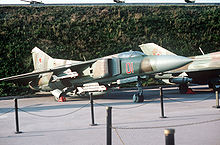
Picture - MiG-23M Flogger-B on display at the Museum of the Great Patriotic war in Kiev.
MiG-23M ('Flogger-B) This variant first flew on June 1972. It was the first truly mass-produced version of the MiG-23, and the first VVS fighter to feature look-down/shoot-down capabilities (although this capability was initially very limited). The wing was modified again and now featured leading-edge slats. The R-29-300 (R-29A) engine was now rated for 12,500 kp. It finally had the definitive sensor suite: an improved Sapfir-23D (NATO: 'High Lark') radar, a TP-23 infra-red search and track (IRST) sensor and an ASP-23D gunsight. The 'High Lark' radar had a detection range of some 45 km against a high-flying, fighter-sized target. It was not a true Doppler radar but instead utilized the less effective "envelope detection" technique, similar to some radars on Western fighters of the 1960s.
MiG-23MF (Flogger-B) This was an export derivative of the MiG-23M originally intended to be exported to Warsaw Pact countries, but it was also sold to many other allies and clients, as most export customers were dissatisfied with the rather primitive MiG-23MS. It actually came in two versions. The first one was sold to Warsaw Pact allies, and it was essentially identical to Soviet MiG-23M, with small changes in "identify friend or foe" (IFF) transponders and communications equipment. The second variant was sold outside Eastern Europe and it had a different IFF and communications suite (usually with the datalink removed), and downgraded radar, which lacked the electronic counter-countermeasure (ECCM) features and modes of the baseline 'High Lark'. This variant was more popular abroad than the MiG-23MS and considerable numbers were exported, especially to the Middle East.
The infrared system had a detection range of around 30 km against high-flying bombers, but less for fighter-sized targets. The aircraft was also equipped with a Lasur-SMA datalink. The standard armament consisted of two radar- or infrared-guided Vympel R-23 (NATO: AA-7 'Apex') BVR missiles and two Molniya R-60 (NATO: AA-8 'Aphid') short-ranged infrared missiles. From 1974 onwards, double pylons were installed for the R-60s, enabling up to four missiles to be carried. Bombs, rockets and missiles could be carried for ground attack. Later, compatibility for the radio-guided Kh-23 (NATO: AS-7 'Kerry') ground-attack missile was added. Most Soviet MiGs were also wired to carry tactical nuclear weapons. Some 1300 MiG-23Ms were produced for the Soviet Air Force (VVS) and Soviet Air Defense Forces (PVO Strany) between 1972 and 1978. It was the most important Soviet fighter type from the mid-to-late 1970s.
MiG-23U ('Flogger-C) The MiG-23U was a twin-seat training variant. It was based on the MiG-23S, but featured a lengthened cockpit with a second crew station behind the first. One forward fuel tank was removed to accommodate an extra seat-this was compensated for by adding a new fuel tank in the rear fuselage. The MiG-23U had the S-21 weapon system, although the radar was later mostly removed. During its production run, both its wings and engine were improved to the MiG-23M standard. Production began at Irkutsk in 1971 and eventually converted to the MiG-23UB.
MiG-23UB ('Flogger-C) Very similar to MiG-23U except that the R-29-300 turbojet engine replaced the older R-27 installed in the MiG-23U. Production continued until 1985 (for the export variant). A total of 769 examples were built, including conversions from the MiG-23U.
MiG-23MP ('Flogger-E) Similar to the MiG-23MS (described below), but produced in much fewer numbers and was never exported. Virtually identical to MiG-23MS except the addition of a dielectric head above the pylon, which was often associated with the ground-attack versions-for which it might have been a developmental prototype.
MiG-23MS ('Flogger-E) This was an export variant, as the '70s MiG-23M was considered too advanced to be exported to Third World countries. It was otherwise similar to MiG-23M, but it had the S-21 standard weapon system, with a RP-22SM (NATO: 'Jay Bird') radar in a smaller radome, and the IRST was removed. Obviously, this variant had no BVR capability, and the only air-to-air missiles it was capable of using were the R-3S (NATO: AA-2a 'Atoll') and R-60 (NATO: AA-8 'Aphid') IR-guided missiles and the R-3R (NATO: AA-2d 'Atoll') semi-active radar homing (SARH) missile. The avionics suite was very basic. This variant was produced between 1973 and 1978 and exported principally to North Africa and the Middle East.
Second-generation
MiG-23P ('Flogger-G) This was a specialized air-defense interceptor variant developed for the PVO Strany. It had the same airframe and powerplant as the MiG-23ML, but there is a cut-back fin root fillet instead of the original extended one on other models. Its avionics suite was improved to meet PVO requirements and mission profiles. Its radar was the improved Sapfir-23P, which could be used in conjunction with the gunsight for better look-down/shoot-down capabilities to counter increasing low-level threats like cruise missiles. The IRST, however, was absent. The autopilot included a new digital computer, and it was linked with the Lasur-M datalink. This enabled ground-controlled interception (GCI) ground stations to steer the aircraft towards the target; in such an intercept, all the pilot had to do was control the engine and use the weapons. The MiG-23P was the most numerous PVO interceptor in the 1980s. Around 500 aircraft were manufactured between 1978 and 1981. The MiG-23P was never exported and served only within the PVO in Soviet service.
MiG-23bis ('Flogger-G) Similar to the MiG-23P except the IRST was restored and the cumbersome radar scope was eliminated because all of the information it provided could be displayed on the new head-up display (HUD).
MiG-23ML. The early Flogger variants were intended to be used in high-speed missile attacks, but it was soon noticed that fighters often had to engage in more stressful close-in combat. Early production aircraft had actually suffered cracks in the fuselage during their service career. Maneuverability of the aircraft was also criticized. A considerable redesign of the airframe was performed, resulting in the MiG-23ML (L - lightweight), which made it in some ways a new aircraft. Empty weight was reduced by 1250 kg, which was achieved partly by removing a rear fuselage fuel tank. Aerodynamics were refined for less drag. The dorsal fin extension was removed. The undercarriage was redesigned, resulting in a lowered nose attitude on the ground. The airframe was now rated for a g-limit of 8.5, compared to 8 g for the early generation MiG-23M/MF 'Flogger-B'. A new engine model, the R-35F-300, now provided a maximum dry thrust of 8550 kp, and 13,000 kp with afterburner. This led to a considerable improvement in maneuverability and thrust-to-weight ratio. The avionics set was considerably improved as well. The S-23ML standard included Sapfir-23ML radar and TP-23ML IRST. The new radar was more reliable and a had maximum detection range of about 65 km against a fighter-sized target (25 km in look-down mode). The navigation suite received a new, much improved autopilot. New radio and datalink systems were also installed. The prototype of this variant first flew in 1976 and production began 1978.
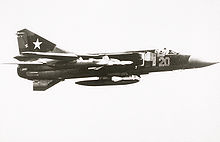
Picture - Soviet MiG-23MLA Flogger-G
MiG-23MLA ('Flogger-G) The later production variant of the 'ML' was redesignated the 'MLA'. Externally, the 'MLA' was identical to 'ML'. Internally, the 'MLA' had an improved radar with better ECM resistance, which made co-operative group search operations possible as the radars would now not jam each other. It also had a new ASP-17ML HUD/gunsight, and the capability to fire improved Vympel R-24R/T missiles. Between 1978 and 1982, around 1100 'ML/MLA's were built for both the Soviet Air Force and export customers. As with the MiG-23MF, there were two different MiG-23ML sub-variants for export: the first version was sold to Warsaw Pact countries and was very similar to Soviet aircraft. The second variant had downgraded radar and it was sold to Third World allies.
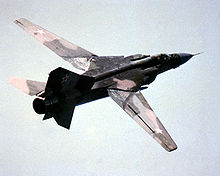
Picture - Soviet MiG-23MLD Flogger-K
MiG-23MLD ('Flogger-K) The MiG-23MLD was the ultimate fighter variant of the MiG-23. The main focus of the upgrade was to improve maneuverability, especially during high angles of attack (AoA).The pitot boom was equipped with vortex generators, and the wing's notched leading edge roots were 'saw-toothed' to act as vortex generators as well. The flight-control system was modified to improve handling and safety in high-AoA maneuvers. Significant improvements were made in avionics and survivability: the Sapfir-23MLA-II featured improved modes for look-down/shoot-down and close-in fighting. A new SPO-15L radar warning receiver was installed, along with chaff/flare dispensers. The new and very effective Vympel R-73 (NATO: AA-11 'Archer') short-range air-to-air missile was added to inventory. No new-build 'MLD' aircraft were delivered to the VVS, as the more advanced MiG-29 was about to enter production. Instead, all Soviet 'MLD's were former 'ML/MLA' aircraft modified to 'MLD' standard. Some 560 aircraft were upgraded between 1982 and 1985. As with earlier MiG-23 versions, two distinct export variants were offered. Unlike Soviet examples, these were new-build aircraft, though they lacked the aerodynamic refinements of Soviet 'MLD's; 16 examples were delivered to Bulgaria, and 50 to Syria. These were the last single-seat MiG-23 fighters made, and the last example rolled off the production line in December 1984.
Ground-attack variants
MiG-23BM ('Flogger-D) This was a MiG-23BK upgrade, with the PrNK-23M replacing the original PrNK-23, and a digital computer replacing the original analog computer. Introduced into service as MiG-27.
MiG-23BM experimental aircraft ('Flogger-D) The MiG-23 ground-attack versions had too much "fighter heritage" for an attack aircraft, and a new design with more radical changes was developed. This was eventually redesignated as the MiG-27 (NATO: 'Flogger-D'). The MiG-23BM experimental aircraft served as a predecessor to the MiG-27 and it differs from the standard MiG-23BM and other MiG-23 models in that its dielectric heads were directly on the wing roots, instead of on the pylons.
MiG-23B ('Flogger-F) The requirement for a new fighter-bomber had become obvious in the late 1960s, and the MiG-23 appeared to be suitable type for such conversion. The first prototype of the project, "32-34", flew for the first time on 20 August 1970. The MiG-23B had a redesigned forward fuselage, but was otherwise similar to the MiG-23S. The pilot seat was raised to improve visibility, and the windscreen was armored. The nose was flat-bottomed and tapered down. There was no radar; instead it had a Sokol-23 ground attack sight system, which included an analog computer, a laser rangefinder and the PBK-3 bomb sight. The navigation suite and autopilot were also improved to provide more accurate bombing. It retained the GSh-23L gun, and its maximum warload was increased to 3000 kg by strengthening the pylons. Survivability was improved by an electronic warfare (EW) suite and inert gas system in the fuel tanks to prevent fire. The first prototype had a MiG-23S type wing, but subsequent examples had the larger "type 2" wing. Most importantly, instead of an R-29 variant, aircraft was powered by the AL-21F-3 turbojet with a maximum thrust of 11,500 kp. The production of this variant was limited, however, as the supply of AL-21 engines was needed for the Sukhoi Su-17 and Su-24 production lines. In addition, this engine was not cleared for export. Only three MiG-23B prototypes and 24 production aircraft were produced in 1971-72.
MiG-23BK ('Flogger-H) These were exported to Warsaw Pact countries-but not to Third World customers-and thus had the PrNK-23 navigation and attack system. Additional radar warning receivers were also mounted on the intakes.
MiG-23BN ('Flogger-H) The MiG-23BN was the definitive fighter-bomber variant. It was otherwise the same as MiG-23B, but had the same R-29-300 engine as contemporary fighter 'Floggers'. They were also fitted with "type 3" wings. There were other minor changes in electronics and equipment, and some changes were made during its long production run. This variant proved to be fairly popular and effective and it was extensively exported. As usual, a downgraded version was sold to Third World customers. Serial production began in 1973 and lasted until 1985, with 624 examples built. Most of them were exported, as the Soviets always viewed it as an interim type and only a small number served in Frontal Aviation regiments. The most distinctive identifying feature between the MiG-23B and MiG-23BN was that the former was rather a developmental aircraft and had the dielectric head just above the pylon, but this was removed from the MiG-23BN.The last of the MiG-23 BNs were flown by 221 Squadron (Valiants) of Indian Air Force and were decommissioned on 6 March 2009. Wing Commander Tapas Ranjan Sahu, was the last pilot to land the Mig-23 BN on that day.
MiG-27 A simplified ground-attack version with simple pitot air intakes, no radar and a simplified engine with two position afterburner nozzle.
Proposed variants and upgrades
MiG-23R was a proposed reconnaissance variant; the project was never finished.
MiG-23MLGD, MLG and MLS were further fighter upgrades with new radar and EW equipment, partly the same as in MiG-29; these variants were also fitted with helmet-mounted sights and were basically MiG-23MLD subvariants. They were abandoned in favor of the then ongoing MiG-29 program.
MiG-23K was a carrier-borne fighter variant based on the MiG-23ML.
MiG-23A was a multirole variant based on the 'K'. However, cancellation and subsesquent redesign of the Soviet aircraft carrier project also caused cancellation of the MiG-23A and MiG-23K variants and subvariants. It was planned to develop the MiG-23A into three different subvariants:
MiG-23AI The MiG-23AI was to be a dedicated fighter.
MiG-23AB The MiG-23AB was to be an attack-dedicated variant.
MiG-23AR MiG-23AR a dedicated reconnaissance variant.
MiG-23MLK Planned to be powered by either two new R-33 engines or one R-100.
MiG-23MD Was basically a MiG-23M fitted with a Saphir-23MLA-2.
MiG-23ML-1 Wwas a variant with several possible powerplant and engine choices; its single-engine options were either one R-100 or one R-69F engine, while its twin-engine arrangement was two R-33 engines. It was planned to be armed with a new air-to-air missile, the R-146.
MiG-23-98 In the late 1990s, Mikoyan, following their successful MiG-21 upgrade projects, offered an upgrade which featured new radar, new self-defense suite, new avionics, improved cockpit ergonomy, helmet-mounted sight, and the capability to fire Vympel R-27 (NATO: AA-10 'Alamo') and Vympel R-77 (NATO: AA-12 'Adder') missiles. The projected cost was around US$1 million per aircraft. Smaller upgrades were also offered, which consisted of only improving the existing Sapfir-23 with newer missiles and upgrades of other avionics. Airframe life extension was offered as well.
MiG-23-98-2 An export upgrade including the Saphir radar fitted to their MiG-23MLs; this radar upgrade allows the Angolan MiG-23s to fire new types of air-to-air and air-to-ground weapons. This radar upgrade seems to be the same offered as part of the radar upgrade.
MiG-23LL (flying laboratory) MiG-23s and MiG-25s were used as the first jet fighter platforms to test a new in-cockpit warning system with a pre-recorded female voice to inform pilots about various flight parameters. A female voice was chosen specifically to provide a clear and intuitive distinction between communications from the ground and the messages from internal systems, since ground communications virtually always came in male voice in Soviet service. The idea proved successful for many reasons besides the original one, and was later heavily borrowed by Western aircraft manufacturers, eventually becoming standard in all jet fighters around the world.
Price
The MiG-23 had the advantage of being quite cheap in the early 1980s. For example, the MiG-23MS was priced between US$3.6 million and US$6.6 million depending on the customer; on the other hand in 1980, the F-16 Fighting Falcon was priced at US$14 million, and the Flogger's closest Western competitor was the Israeli $4.5 million Kfir C2.
Armament
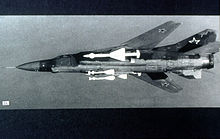
Picture - MiG-23M Flogger-B armed with AA-7 and AA-8 missiles
The MiG-23's armament evolved as the type's avionics were upgraded and new variants were deployed. The earliest versions, which were equipped with the MiG-21's fire control system, were limited to firing variants of R-3 (AA-2 'Atoll'). The R-60 (AA-8 'Aphid') replaced the R-3 during the '70s, and from the MiG-23M onwards the R-23/R-24 (AA-7 'Apex') was carried. The MiG-23MLD Flogger is capable of firing R-73 (AA-11 'Archer') when it became available, but this missile was not exported until the MiG-29 was released for export. The helmet-mounted sight associated with the AA-11 'Archer' (R-73) was fitted on the MiG-23MLDG and other experimental MiG-23MLD subvariants that never entered production as had been originally planned. The reason was that these MiG-23MLD subvariants had less priority than the then ongoing MiG-29 program, and the Mikoyan bureau therefore decided to concentrate all their efforts on the MiG-29 program and halted further work on the MiG-23s. Nevertheless, a helmet-mounted sight is now offered as part of the MiG-23-98 upgrade. There were reports about the MiG-23MLD being capable of firing the AA-10 'Alamo' (R-27) beyond its firing experimental tests; however, it seems only Angola's MiG-23-98 are capable of doing so. A MiG-23 was used to test and fire the AA-10, AA-11 and AA-12 air-to-air missiles during their early flight and firing trials. Ground-attack armament included 57 mm rocket pods, general purpose bombs up to 500 kg in size, gun pods, and Kh-23 (AS-7 'Kerry') radio-guided missiles. Up to four external fuel tanks could be carried.
Operational history
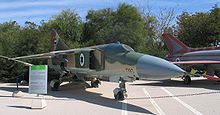
Picture - Captured MiG-23 on display in Israel
Western and Russian aviation historians usually differ in respect to the MiG-23's combat record, in part due to the bias in favor of their respective national aircraft industries. They also usually accept claims going along with their respective political views since usually many conflicting and contradictory reports are written and accepted by their respective historians. Little pictorial evidence has been published confirming MiG-23 air to air losses and victories, with the exception of a SAAF Mirage F1 shot down by a Cuban MiG-23ML, the Libyan MiG-23s shot down by U.S. Navy F-14s and two pictures of Syrian MiG-23s shot down in 1982 by Israeli forces.
Russians and Syrian claim numerous successes for MiG-23s, which are not confirmed by Israeli sources:
On 19 April 1974 a MiG-23MS flown by Maj. El al-Masry is reported to have shot down 2 IAF F-4Es during a mission over the Golan Heights against an Israeli offensive to destroy Syrian SAMs. He was subsequently shot down by an Israeli air-to-air missile in conjunction with friendly fire from a SA-6 battery. Israeli sources state that only one Phantom was lost on that day.
26 April 1981, two MiG-23MS, are said to have shot down two A-4 Skyhawks.
The first MiG-23s to see combat were export variants with many limitations. For example, the MiG-23MS lacked a radar warning receiver. In addition, compared to the MiG-21, the aircraft was mechanically complex and expensive. Early export variants also lacked many "war reserve modes" in their radars, making them vulnerable against electronic countermeasures (ECM), at which the Israelis were especially proficient. Israel claims that during the period of 1982-1985 no Israeli aircraft was lost to enemy aircraft and that Israel only lost five aircraft shot down by Syrian SAMs. Israeli reports (which have been endorsed by the majority of Western historians) claim that during the period of intense fighting from 6-11 June 1982, 85 Syrian aircraft were shot down in air combat. At least 30 of these aircraft were reported by Israeli sources to be MiG-23s, but mainly the specialized ground attack version, the MiG-23BN.
The Israelis also claim that their F-15s downed two MiG-23MLs in 1985. According to Soviet/Russian historians, the MiG-23MS did achieve kills in this war also. One of these victories was achieved on 11 June 1982, when a pair of MiG-23MS pilots, named Heyrat and Zabi, brought down an Israeli F-4 with two AA-2s. Both MiG-23MS pilots were then shot down.
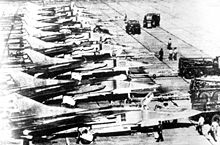
Picture - Line of Cuban MiG-23s.
This Soviet/Russian source also states the Syrians lost 24 MiG-23s, including six MiG-23MFs, four export MiG-23MSs and fourteen MiG-23BN ground-attack variants. At the same time, Syrian MiG-23s managed to shoot down at least five F-16s, two F-4Es, and a BQM-34 unmanned reconnaissance plane. These are some of the Syrian MiG-23 kills as described in a Soviet/Russian source:
On 7 June 1982, three MiG-23MFs (pilots Hallyak, Said, and Merza) attacked a group of F-16s. Captain Merza detected the F-16s at a distance of 25 km and brought down two F-16s with R-23 (AA-7 "Apex") missiles (one from 9 km and another within the distance of 7 or 8 km) before he himself was shot down.
On 8 June 1982, two MiG-23MFs again met with F-16s. Major Hau's MiG-23 detected an F-16 at a distance of 21 km and shot it down with an R-23 from a distance of 7 km. Again, the Syrian pilot was himself shot down by an AIM-9 Sidewinder fired from another F-16.
On 9 June 1982, two MiG-23MFs, piloted by Deeb and Said, attacked a group of F-16s. Deeb brought down an F-16 from a distance of 6 km with an R-23, but was then shot down, most likely by a Sidewinder.
Soviet/Russian source further states that three Israeli F-15s and one F-4 were shot down in October 1983 by the newly delivered MiG-23MLs, with no Syrian losses since. According to other Soviet/Russian sources, it happened in October 1982 or in December 1982.
The MiG-23 took part in the Iran-Iraq War and was used in both air-to-air and air-to-ground roles. The reports about performance in air combat are mixed - some authors claim that Iraqi MiG-23s had some victories and several losses against Iranian F-14s and F-4s. For example it is said that Colonel Mohammed-Hashem All-e-Agha was shot down by an Iraqi MiG-23 while flying his F-14 on 11 August 1984. Furthermore, Capt. Bahram Ghaneii was shot down by a MiG-23ML on 17 January 1987. According to Iranian sources, four MiG-23s were shot down by F-14s on 29 October 1980.
Cuban MiG-23MLs and South African Mirage F1 pilots had several encounters during the Angolan Civil War, one of which resulted in a Mirage being lost. On 27 September 1987, during Operation Moduler, two MiG-23 pilots surprised a pair of Mirages and fired missiles: Alberto Ley Rivas engaged a Mirage flown by Capt Arthur Piercey with a pair of R-23Rs (some sources say a R-60), while the other Cuban pilot fired a single R-60 at a Mirage flown by Captain Carlo Gagiano. Although the missiles homed on the Mirages, only one R-23R exploded close enough to cause damage - to the landing hydraulics of Capt Piercey's Mirage (and, according to some accounts, the aircraft's drag chute). The damage likely contributed to the Mirage veering off the runway on landing, after which the nose gear collapsed. The nose hit the ground so hard that Piercey's ejection seat fired. As a the result of this ground level ejection, Piercey was paralyzed. The aircraft was destroyed.
Soviet MiG-23s and Pakistani F-16s clashed a few times during the Soviet war in Afghanistan. One F-16 was lost in 1987, when the AIM-9 Sidewinder missile fired from an accompanying F-16 at an intruding Soviet MiG-23 switched its target lock, and locked onto the first F-16 instead. Pakistan considers it a friendly fire incident, but the Soviet-backed Afghan government of the time claimed that its soviet aircraft downed the Pakistani F-16 - a claim that the New York Times and the Washington Post investigated. and only later the Pakistani side recanted the event. According to the Russian version of the event, the F-16 was shot down when Pakistani F-16s encountered Soviet MiG-23MLDs. Soviet TASS originally reported the event as the F-16 being shot down by Afghan air defenses. Soviet MiG-23MLD pilots, while on a bombing raid, reported being attacked by F-16s and then seeing one F-16 explode. It could have been downed by gunfire from a MiG whose pilot did not report the kill in fear of punishment, since this would had complicated the political situation for the former USSR, . According to Pakistani sources, the F-16 piloted by Flt.Lt. Shahid Sikander was shot down in a friendly fire incident, after he flew directly in front of his flight leader and was hit by an AIM-9 Sidewinder fired at the Mig-23s. This version has been cited with more credibility by western sources claiming the MiG-23MLD were on a ground attack mission and therefore not equipped with air to air missiles, however this does not mean the MiG-23 could not have outflown and outsmart the F-16s pilots as sometimes have been suggested since the AIM-9 was aimed at a MiG-23 and not to an F-16.
A year later, Soviet MiG-23MLDs using R-24s (NATO: AA-7 "Apex") downed two Iranian AH-1J Cobras that had intruded into Afghani airspace. In a similar incident a decade earlier, on 21 June 1978, a PVO MiG-23M flown by Pilot Captain V. Shkinder shot down two Iranian Boeing CH-47 Chinook helicopters that had trespassed into Soviet airspace, one helicopter being dispatched by two R-60 missiles and the other by cannon fire.
At least one Libyan MiG-23MS was shot down by an Egyptian fighter during and immediately after the Libyan-Egyptian War in 1977. In one skirmish, two LARAF MiG-23MS engaged two EAF MiG-21MF which had been upgraded to carry western weaponry. The Libyan pilots made the mistake of trying to out-maneuver more nimble Egyptian fighters, and one MiG-23MS was shot down by Maj. Sal Mohammad with an AIM-9 Sidewinder missile, while the other used its superior speed advantage to escape. Two Libyan MiG-23MS fighters were shot down by U.S. Navy F-14s in the Gulf of Sidra incident in 1989.
During the Persian Gulf War, the USAF reported downing eight Iraqi MiG-23s with F-15s. Some Russian sources claim that a U.S. F-16 and an Italian Tornado were shot down by Iraqi MiG-23 in this war; however the Italian Air Force maintained that the only Tornado lost during the war (pilots: Bellini and Cocciolone) was shot down by a surface-to-air missile
Other claims include the story about an Iraqi pilot named Hassan, flying a MIG-23 having supposedly damaged an F-111 with and R-24T missile at 4:30 somewhere south of Balad airbase, and at 5:10 another F-111 (tail number 70-2384) being damaged by another R-24T missile fired by a MiG-23. But in a similar fashion to the Italian Tornado and Israeli F-16 claimed shot down by MiG-23 as the Russians historians affirm, the USAF sustains that while an unidentified F-111F was indeed damaged near Balad airbase, and F-111F with tail number 70-2384 also did not return intact, neither damage had anything to do with missile hits: an F-111F was hit by Iraqi anti-aircraft cannon fire south of the airbase in question, while the F-111F with tail number 70-2384 suffered a mid-air collision with a KC-135 tanker.
An Iraqi MiG-23 was shot down by a USAF F-16 using an AMRAAM missile in January 1993, during skirmishes in the No-Fly-Zones.
In Eritrea in 1999 3 Ethiopian MiG-23BNs were shot down by Eritrean MiG-29s in a small border war in 1999. The type also saw extensive use as a bomber.
Soviet and Warsaw Pact service
Because of its distinctive appearance with large air intakes on both sides of the fuselage the aircraft was nicknamed "Cheburashka" by some Soviet pilots after a popular Russian cartoon character representing a fictional animal with big ears. The nickname did not stick and was later firmly assigned to Antonov An-72/74, although to this day it is sometimes applied to different aircraft with similar exterior features, including the USAF A-10 Thunderbolt II.
The aircraft was not used in large numbers by the non-Soviet air forces of the Warsaw Pact as originally envisioned. When the MiG-23s were initially deployed, they were considered the elites of the Eastern Bloc air forces. However, very quickly the disadvantages became evident and the MiG-23 did not replace the MiG-21 as initially intended. The aircraft had some deficiencies that limited its operational serviceability and its hourly operating cost was thus higher than the MiG-21’s. The Eastern Bloc air forces used their MiG-23s to replace MiG-17s and MiG-19s still in service.
By 1990, over 1,500 MiG-23s of different models were in service with VVS and PVO. With the dissolution of the Soviet Union, the Russian Air Force began to cut back its fighter force, and it was decided the MiG-23s and MiG-27s were among the types which were to be retired to operational storage. The last model to serve was the MiG-23P, which was retired in 1998.
When East and West Germany unified, no MiG-23s were transferred to the Luftwaffe, but twelve former East German MiG-23s were supplied to the U.S. When Czechoslovakia split into the Czech Republic and Slovakia, the Czechs received all the MiG-23s, which were retired in 1998. Hungary retired their MiG-23s in 1996, Poland in 1999, Romania in 2000, and Bulgaria in 2004.
The MiG-23 was the Soviet Air Force's "Top Gun"-equivalent aggressor aircraft from the late 1970s to the late 1980s. It proved a difficult opponent for early MiG-29 variants flown by inexperienced pilots. Exercises showed when well-flown, a MiG-23MLD could achieve favorable kill ratios against the MiG-29 in mock combat by using hit-and-run tactics and not engaging the MiG-29s in dogfights. Usually the aggressor MiG-23MLDs had a shark mouth painted on the nose just aft of the radome, and many were piloted by Soviet-Afghan War veterans. In the late 1980s, these aggressor MiG-23s were replaced by MiG-29s, also featuring shark mouths.
Performance tests
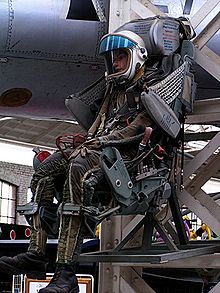
Picture - Such ejection seats of type KM-1 were used in the MiG-21 and MiG-23.
Many potential enemies of the USSR and its client states had a chance to evaluate the MiG-23’s performance. In the 1970s, after a political realignment by the Egyptian government, Egypt gave their MiG-23MS to the United States and the People's Republic of China in exchange for military hardware. In the US, these MiG-23MS and other variants acquired later from Germany were used as part of the evaluation program of Soviet military hardware. Dutch pilot Leon Van Maurer, who had more than 1200 hours flying F-16s, flew against MiG-23ML Flogger-Gs from air bases in Germany and the U.S. as part of NATO's aerial mock combat training with Soviet equipment. He concluded the MiG-23ML was superior in the vertical to early F-16 variants, just slightly inferior to the F-16A in the horizontal, and has superior beyond visual range (BVR) capability.
The Israelis tested a MiG-23MLD that defected from Syria and found it had better acceleration than the F-16 and F/A-18.
Another MiG-23 evaluation finding in the US and Israel reports was that the MiG-23 has a Head-Up Display (HUD) that doubles as a radarscope, allowing the pilot to keep his eyes focused at infinity and work with his radar. It also allowed the Soviets to dispense with the radarscope on the MiG-23. This feature was carried over into the MiG-29, though in that aircraft a cathode ray tube (CRT) was carried on the upper right corner to double as a radarscope. Western opinions about this "head-up radarscope" are mixed. The Israelis were impressed, but an American F-16 pilot criticizes it as "sticking a transparent map in front of the HUD" and not providing a three-dimensional presentation that will accurately cue a pilot's eyes to look for a fighter as it appears in a particular direction.
Besides the Syrian defection, a Cuban pilot flew a MiG-23BN to the US in 1991 and a Libyan MiG-23 pilot also defected to Greece in 1981. In both cases, the aircraft were later returned to their countries.
The early MiG-23M series was also used to test the American F-5s captured by the North Vietnamese and sent to the former USSR for evaluation, however the Russians acknowledged the F-5 was a very agile aircraft and at some speeds and altitudes better than the MiG-23M, this was one of the main reasons the MiG-23MLD and MiG-29 developments were started. These tests of the F-5 allowed the Russians to make modifications to several of their 4th generation aircraft, however despite the MiG-23 was not designed to combat F-5s, it showed the weaknesses of the early MiG-23 variants .
Early western reports claimed that the aircraft also had poor dogfighting capability, due to being designed to out-accelerate the F-111 Aardvark. however later analysis showed it was a F-4 equivalent and it was only surpassed by newer fighters like the F-15 and F-16 of the fourth generation, the MiG-23 is a third generation fighter like the Mirage F1 and AJ-37 Viggen, the Soviet combat manual for MiG-23MLD pilots says the MiG-23MLD has some slight superiority over the F-4 and Kfir but is not a match for the F-15 and F-16 in most combat parameters, it also recommends the tactics to be used against these fighters
Operators
Current operators
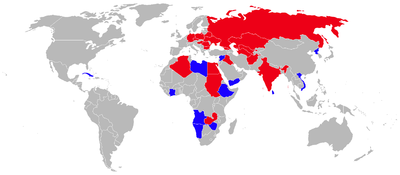
Picture - MiG-23 operators (former operators in red)
Angola National Air Force of Angola. 32 MiG-23M/UB in service Cx´te d'Ivoire Cote d'Ivoire Air Force. Received two MiG-23MLD from Bulgaria in the late 1990s. [5] Cuba Cuban Air Force. 69 MiG-23MF/ML/UB in service (most grounded) Ethiopia Ethiopian Air Force. 32 MiG-23BN/UB in service for ground attack role. The interceptor variant, MIG-23ML, was withdrawn from service.
Libya Libyan Air Force. 130 MiG-23MS/ML/BN/UB in service (most in storage), Libyan Air Force will operate them until 2011. Namibia Namibian Air Force 2 MiG-23 aircraft in service. North Korea North Korean Air Force. 66 MiG-23ML/UB in service Sri Lanka Sri Lanka Air Force. One MiG-23UB trainer used only for training purposes for their MiG-27 fleet Syria Syrian Air Force. 146 MiG-23MS/MF/ML/MLD/BN/UB in service Yemen Yemen Air Force. 44 MiG-23BN/UB in service Vietnam Vietnam People's Air Force. 36 Mig-23ML/UB in service Zimbabwe Air Force of Zimbabwe. 3 MiG-23M/UB were seen in a fly past in 2003
Former operators
Armenia Afghanistan Afghan Air Force. MiG-23BN/UB may have served with the Afghan Air Force from 1984. It is unclear whether these were merely Soviet aircraft wearing Afghan colors. Algeria Algerian Air Force. Belarus Belarus Air Force. Bulgaria Bulgarian Air Force. A total of 90 MiG-23s served the Bulgarian Air Force from 1976 to their withdrawal from service in 2002. The exact count is: 33 MiG-23BN, 12 MiG-23MF, 1 MiG-23ML, 8 MiG-23MLA, 21 MiG-23MLD and 15 MiG-23UB. Czech Republic Czech Air Force. MiGs were retired in 1994 (BN,MF version) and 1998 (ML, UB variant). Czechoslovakia Czechoslovakian Air Force. MiG-23s were transferred to the Czech Republic. East Germany East German Air Force. Transferred to (West) German Luftwaffe. The German Luftwaffe gave two MiG-23s to USAF and one to a museum in Florida, the others were given away to others states or scrapped. Egypt Egyptian Air Force. Six MiG-23BN/MS/U were sent to China in exchange for military hardware; China used them to reverse engineer the MiG-23 as the Q-6 but since the Chinese could not reverse engineer the R-29 and build a reliable turbofan the only MiG-23 elements that were used ended in the J-8II. At least 8 were transferred to USA for evaluation. Georgia Georgian Air Force Hungary Hungarian Air Force. 16 MiG-23 served and were withdrawn in 1997; the exact count is: 12 MiG-23MF and 4 MiG-23 UB (one of them was purchased in 1990 from the Soviet Air Force). India Indian Air force. MiG-23BN ground attack aircraft phased out on 6 March 2009 & MiG-23MF air defence interceptor phased out on 2007. A total of 95 MiG-23BN had been obtained. Iran 9 flown over from Iraq in 1991 in storage. Iraq Iraqi Air Force. Some Iraqi MiG-23s were sent to Yugoslavia for upgrades when Gulf war started. 1 known example remains in Serbia at the Museum of Aviation in Belgrade. Kazakhstan Military of Kazakhstan. 100 MiG-23M/UB were in service
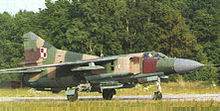
Picture - Polish Air Force MiG-23
Poland Polish Air Force. 36 MiG-23MF single-seaters and six MiG-23UB trainers were delivered to the Polish Air Force between 1979 and 1982. Last of them were withdrawn in September 1999. Romania Romanian Air Force. 46 MiG-23 served from 1979 until 2001 and were withdrawn in 2003; the exact count is: 36 MiG-23MF and 10 MiG-23 UB. Russia Russian Air Force. Approx 500, all in reserve. Sudan Sudanese Air Force. Turkmenistan Military of Turkmenistan. Soviet Union Passed on to successor states.
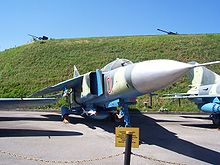
Picture - Ukrainian MiG-23 on display at the Museum of the Great Patriotic War, Kiev
Soviet Air Force
Soviet Anti-Air Defence
Ukraine Ukrainian Air Force Uzbekistan Military of Uzbekistan 31 in service. Zambia Military of Zambia.
Evaluation only users
China
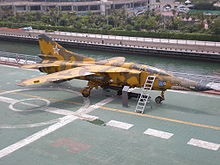
Picture - MiG-23 on display at the Minsk World theme park in Shenzhen, PRC.
MiG-23s were obtained from Egypt, and an attempt was made to reverse engineer them as the Q-6, however the program did not go ahead and the Q-6 was not built, however some features from the MiG-23 features were incorporated into the J-8II. China currently displays the MiG-23 in several air museums.
Israel
One ex-Syrian plane flown by a defecting pilot to Israel.
United States
Samples obtained from Egypt remained flight worthy until the late 1980s and were mostly stationed in Nellis Air Force Base
The Cold War Air Museum (CWAM) is returning a MiG-23UB to flying condition from its Museum at Lancaster Airport (Texas) just south of Dallas, Texas.
Yugoslavia
Some ex-Iraqi MiG-23's have been used by Flight Test Center (VOC) in early 1990s.
The Albanian Air Force never flew the MiG-23.
Civilian operators
United States
Two ex-Czech aircraft, N51734 and N5106E, are registered for civilian use in the United States and are based at New Castle Airport in Wilmington, Delaware.
An ex-Bulgarian VVS aircraft, N923UB, is operational and on display at the Cold War Air Museum near Dallas, Texas.
Notable incidents and accidents
On July 18, 1980, 21 days after the Aerolinee Itavia Flight 870 incident, the wreckage of a Libyan MiG-23 was found on the Sila Mountains in Castelsilano, Calabria, southern Italy, according to official reports.
On April 26, 1984, United States Air Force Lieutenant General Robert M. Bond was killed when the MiG-23 he was piloting crashed at the Nevada Test Site. At the time of the mishap, Lt. Gen. Bond was serving as Vice Commander of Air Force Systems Command at Andrews Air Force Base, Maryland.
4 July 1989: A "runaway" Soviet MiG-23 crashed into a house in Belgium, killing an 18-year-old man.
22 December 1992: Libyan Arab Airlines Flight 1103 collides with a Libyan Air Force MiG-23 causing both to crash.
Specifications (MiG-23MLD Flogger-K)
General characteristics
Crew: One
Length: 16.70 m (56 ft 9.5)
Wingspan: Spread, 13.97 m (45 ft 10 in)
Height: 4.82 m (15 ft 9.75 in)
Wing area: 37.35 m² spread, 34.16 m² swept (402.05 ft² / 367.71 ft²)
Empty weight: 9,595 kg (21,153 lb)
Loaded weight: 15,700 kg (34,612 lb)
Max takeoff weight: 18,030 kg (39,749 lb)
Powerplant: 1x— Khatchaturov R-35-300 afterburning turbojet, 83.6 kN dry, 127 kN afterburning (18,850 lbf / 28,700 lbf)
Performance
Maximum speed: Mach 2.32, 2,445 km/h at altitude; Mach 1.14, 1,350 km/h at sea level (1,553 mph / 840 mph)
Range: 1,150 km with six AAMs combat, 2,820 km ferry (570 mi / 1,750 mi)
Service ceiling: 18,500 m (60,695 ft)
Rate of climb: 240 m/s (47,245 ft/min)
Wing loading: 420 kg/m² (78.6 lb/ft²)
Thrust/weight: 0.88
Armament
1x Gryazev-Shipunov GSh-23L 23 mm cannon with 200 rounds
Two fuselage, two wing glove, and two wing pylons for up to 3,000 kg (6,610 lb) of stores, including:
R-23/24 (AA-7 Apex)
R-60 (AA-8 Aphid)
also, upgraded aircraft may carry:
R-27 (AA-10 Alamo)
R-73 (AA-11 Archer)
R-77 (AA-12 Adder)
According to the MiG-23ML manual, the MiG-23ML has a maximun sustained turn rate of 14.1 deg/sec and a maximum instantaneous turn rate of 16.7 deg/sec. The MiG-23ML accelerates from 600 km/h (373 mph) to 900 km/h (559 mph) in just 12 seconds at the altitude of 1000 meters. The MiG-23 accelerates at the altitude of 1 km from the speed of 630 km/h (391 mph) to 1300 km/h (808 mph) in just 30 seconds and at the altitude of 10-12 km will accelerate from Mach 1 to Mach 2 in just 160 seconds.
Related development
Mikoyan MiG-27
Comparable aircraft
Dassault Mirage F1
Shenyang J-8
General Dynamics F-111 Aardvark
Living Warbirds: The best warbirds DVD series.
Source: WikiPedia